This delicious vanilla cake just happens to be gluten free.
I really think that you could serve this Gluten Free Vanilla Cake to any group of people, gluten free or not, and no one will ever guess that it's a gluten free cake.
Every layer bakes up fluffy, with a perfectly flat top, a light and tender crumb, and a gorgeous vanilla flavor. No weird after taste. No dense or grainy consistency. Just a perfectly delicious vanilla cake that can easily become your go-to gluten free recipe for wedding cakes, birthday cakes, shower cakes, anniversary cakes, or just because cakes.
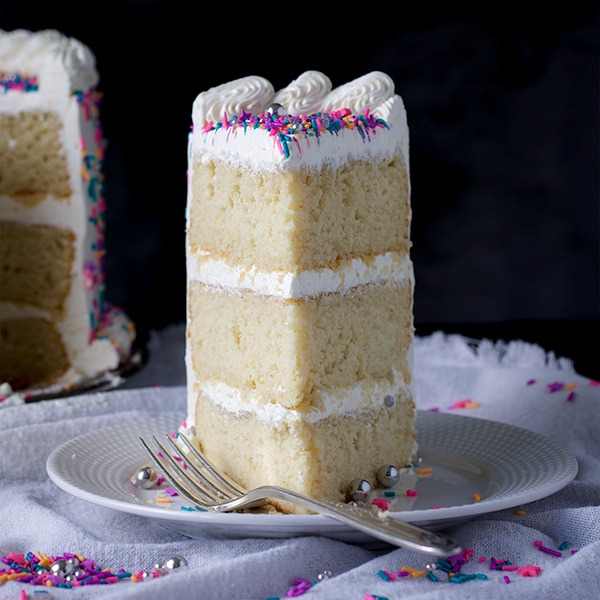
Baking a truly delicious gluten-free cake is not an easy thing.
(And all the gluten free bakers of the world sigh and say, "No sh*t Sherlock.")
This matters because there are so many traditional foods that are seeped into our culture, conditioning our pallets AND our social expectations. Just a few examples off the top of my head: birthday cakes, Christmas cookies, Thanksgiving pie, breakfast and brunch pastries, bread in every form at every meal.
ALL of these culinary staples were created with wheat and all rely on gluten for their structure and flavor.
So, if you're gluten free, or cooking and baking for someone who is gluten free, you have two choices: give up all those cultural culinary staples, or try to make copycat gluten free versions.
Most of us (myself included), when faced with choices like this, quite literally want to have our cake and eat it too. But finding ways of combining other ingredients to mimic everything that wheat and gluten contributes to foods is NOT an easy task.
Today's grocery store shelves are stocked with an ever growing variety of gluten free baking mixes and flour substitutions. But they tend to be on the pricy side and many (most, even) are not very good. The frustrating thing is that in order to know that they aren't very good you have to purchase them and try them out, resulting in time and money spent on something that is most likely going to end up in the trash.
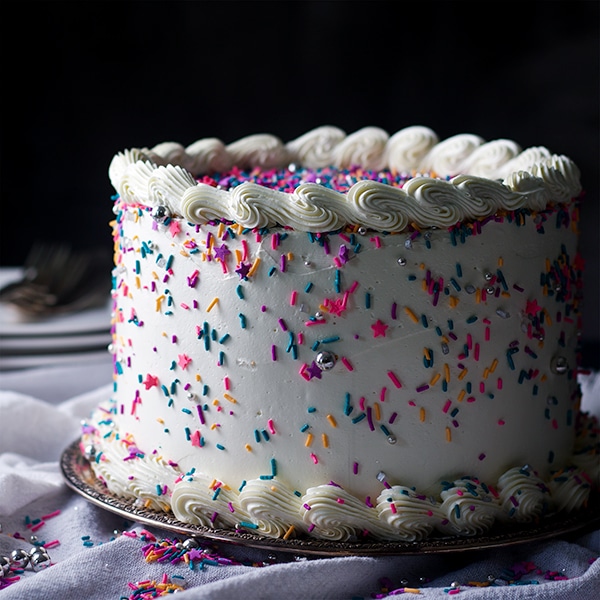
Why this recipe works
When I started working on a recipe for Gluten Free Vanilla Cake, I really wanted to find a prepared gluten free flour substitute that I could use instead of the cake flour in my favorite Vanilla Cake recipe. So, that's where I started.
Several gluten free flour mixes and many cakes in the trash later, I gave up on that idea and embraced the fact that I was going to need to create a specific blend just for this cake.
I DO think that a few of the gluten free flour mixes I tested might be fantastic in certain cakes and muffins. But, they didn't work in this vanilla cake.
The thing I love so much about my favorite Vanilla Cake recipe is that the flavors are so clean and bright. Every bite offers a mouthful of sweet buttery vanilla flavor, without any weird after taste or competing flavors mucking it up. That's what I wanted for the gluten free version, and I just couldn't get it from a pre-made mix.
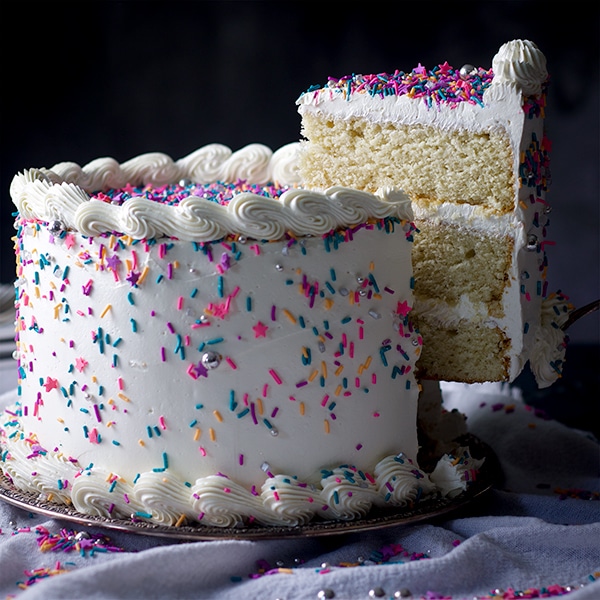
Key ingredients in this recipe
After playing around with several different combinations of gluten free flours, I settled on a blend of:
- Superfine Brown Rice Flour
- Potato Starch
- Tapioca Flour, and
- Nonfat Dry Milk Powder
Let's talk a bit about why each of these ingredients are important to the final texture and flavor of this vanilla cake.
Superfine brown rice flour. The first thing I want to say here is that it's super duper important to use SUPERFINE brown rice flour. Rice flour not labeled "superfine" or "extra fine" will result in a cake that's gritty and crumbly rather than soft, light, and fluffy. One of the biggest advantages to using rice flour in gluten free baking is that it contains a high percentage of protein - about 7% - without the grittiness that comes with other high protein gluten free flours.
One caveat with rice flour is that it doesn’t absorb liquid and fat in the same way wheat flour does. This can cause a sort of mushy consistency in cakes. The solution, which you'll see in the recipe, is to blend the rice flour with buttermilk and let it sit for a few minutes, giving it time to absorb the liquid, before adding it to the cake batter.
Potato Starch and Tapioca Flour. Potato starch is flavorless and contributes structure, tenderness and binding to this vanilla cake. But, too much results in a dry, crumbly texture. Tapioca Flour contributes a chewy texture, and some elasticity and structure to this cake. But, too much can make the baked texture too dense.
(Just to confuse us, Tapioca Starch and Tapioca Flour ARE the same thing. But, Potato Starch and Potato Flour are NOT the same thing. For this cake recipe, make sure you're using Potato Starch.)
Nonfat Milk Powder. I found that just ½ cup of potato starch and a little over ¼ cup of tapioca flour was the perfect amount to take advantage of their ability to add structure and elasticity to the cake without ending up with a dense, crumbly, hockey puck. But, the cake had a of starchy texture that I wanted to try and get rid of.
As it turns out, nonfat milk powder does a wonderful job of coating all those starchy granules and creating a texture that's nearly identical to a cake made with wheat flour.
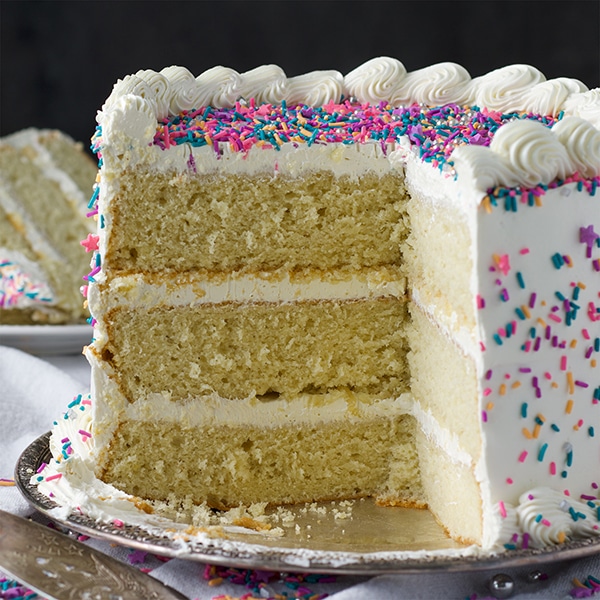
What is Xanthan gum?
Xanthan Gum sounds like something you might not really want to put in your food. In actuality, it's a natural carbohydrate, made from corn sugar that's been fermented with the bacteria Xanthomonas campestris. As you might have guessed, the bacteria is where Xanthan Gum gets its name.
Even though you mostly hear about Xanthan Gum in relation to gluten free baking, it's actually found in all sorts of common foods, from sauces and dressings to ice cream and yogurt.
Xanthan Gum is essential to nearly all gluten free baked goods because it replaces some of the thickening power and elasticity normally provided by gluten. When Xanthan Gum is mixed with liquid, it becomes gel-like. When mixed into cake batter, those binding properties hold the batter together and keep the finished cake from turning into a crumbly mess.
How to fill and frost this cake
This is a true all-purpose recipe for gluten free vanilla cake, and the number of frosting and filling options are limitless.
I am a sucker for vanilla cake and Vanilla Italian Meringue Buttercream, but I certainly wouldn't turn down a slice filled with my favorite pastry cream, strawberry rhubarb jam or peach preserves.
This cake also pairs well with pretty much any variety of flavored version of Italian Meringue Buttercream – fresh berry, lemon, chocolate, caramel, and coconut maple buttercream are just a few of my favorites. Sometimes I flavor only part of a batch of Italian Meringue Buttercream, filling the layers with the flavored version and keeping the outside frosted in vanilla buttercream. Other times, I frost and fill with whatever flavor strikes my fancy.
This cake is also delicious frosted with classic American buttercream or raspberry cream cheese frosting, both of which only take about 10 minutes to make.
And, of course, vanilla cake is pure heaven when iced with Milk Chocolate Buttercream.
The only thing I’d be cautious of when deciding how to fill and frost this vanilla cake is adding fresh fruit. Fruit jam, preserves, or fruit flavored buttercream work really well. But, fresh fruit generally contains too much moisture.
As the moisture leaks out of the fruit, it can soak into the cake layers making them kind of soggy and even causing the layers to slip, toppling your cake over.
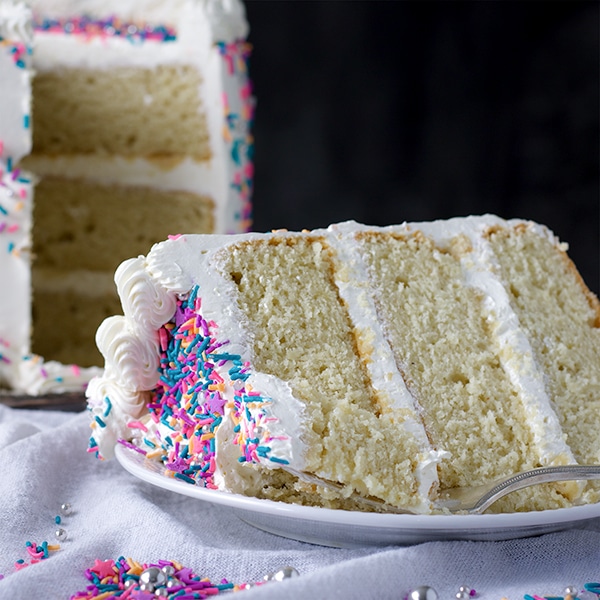
Used in this gluten-free vanilla cake recipe:
- Wilton Cake Pan, 8-inches by 3-inches
- Angled Icing Spatula
- KitchenAid 6-Quart Professional Mixer
- Italian Meringue Buttercream
- Sprinkles!
- Superfine Brown Rice Flour
- Potato Starch
- Tapioca Flour
- Xanthan Gum
More popular Gluten Free Recipes:

- Gluten Free Caramel Cake with Salted Caramel Italian Meringue Buttercream
- Chewy Chocolate Brownie Cookies
- Chocolate Peanut Butter Bars
- Gluten Free Banana Muffins
If you give this recipe a try, let me know! Leave a comment, rate it, or take a picture and tag it #ofbatteranddough on Instagram.
Happy baking!
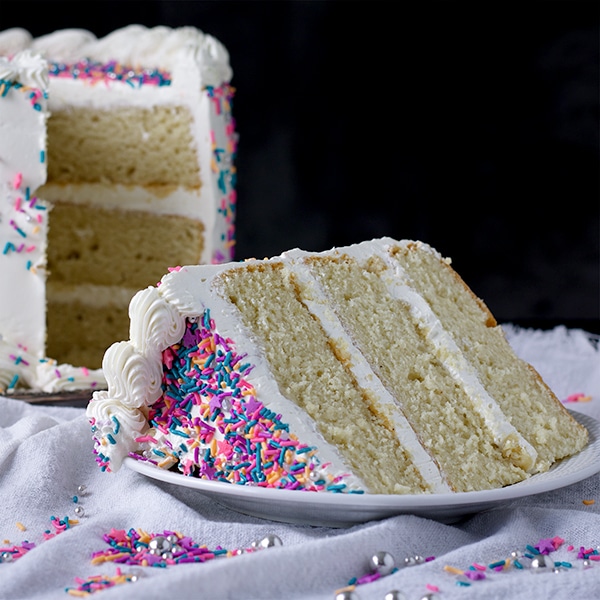
📖 Recipe
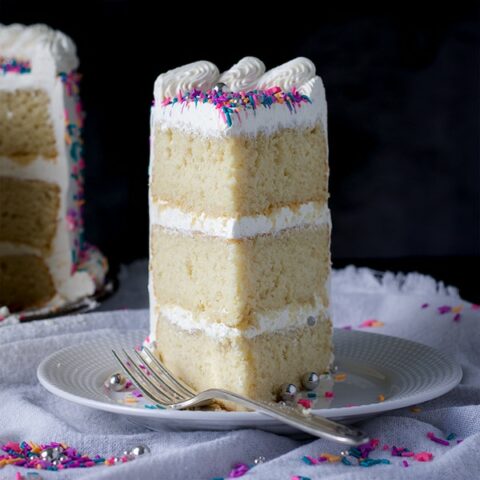
Gluten Free Vanilla Cake
Ingredients
- 2 cups MINUS 2 tablespoon superfine brown rice flour (plus more for dusting the cake pans)
- 1 cup buttermilk, full fat, at room temperature
- 5 whole eggs, separated, at room temperature
- 2 egg whites, at room temperature
- 2 ¼ cups sugar, divided
- ¾ cup butter, at room temperature
- ¾ cup shortening
- 1 tbs pure vanilla extract
- ½ teaspoon lemon extract (optional)
- ½ cup potato starch
- ¼ cup tapioca flour
- ¼ cup dry nonfat milk powder
- 3 teaspoon Xanthan gum
- 2 teaspoon baking powder
- 1 teaspoon salt
- ¼ teaspoon nutmeg
Instructions
- Whisk the superfine brown rice flour and buttermilk together in a medium size bowl until smooth. Set aside.
- Heat oven to 325. Using superfine brown rice flour and butter or shortening, grease and flour three 8 or 9-inch round cake pans, and line the bottoms with a round of parchment paper that is also slathered with a bit of butter or shortening.
- Separate the 5 whole eggs, placing the 5 yolks in a small bowl and the whites in a separate medium
size bowl. Add the 2 additional egg whites so that you have a total of 7 egg whites. Using an electric mixer, beat the egg whites until frothy. Slowly pour in ¼ cup of the sugar, beating as you pour. Continue to beat until the meringue is glossy and stiff peaks form when you lift the whisk from the beaten egg whites. Set aside. - Fit the standing mixer with the whisk attachment and cream the butter, shortening, and remaining 2 cups of sugar until very light and fluffy, about 6 minutes. Stop the mixer to scrape down the sides of the bowl a time or two. Beat in the vanilla and lemon extracts until well combined.
- Add the egg yolks one at a time, beating each until fully incorporated, about 20 seconds, before adding another. Stop to scrape down the sides of the bowl from time to time.
- Add the potato starch, tapioca flour, nonfat milk powder, Xanthan gum, baking powder, salt, and nutmeg to a medium bowl and mix with a wire whisk to combine.
- Add the buttermilk and rice flour mixture to the stand mixer bowl along with the dry ingredients. Beat on medium-high speed for about 60 seconds, until the batter is completely smooth.
- With a rubber spatula, gently fold the beaten egg whites into the batter just until incorporated. Be
gentle - you want to retain as much air in the batter as possible. - Divide the batter evenly between the prepared pans. Bake for 40-50 minutes. When done, the cakes will be golden brown and pulling away from the sides of the pan. To check for doneness, stick a toothpick into the center of one of the layers. Remove the toothpick and look for signs of raw batter. If only cake crumbs stick to the toothpick, the cake is done. You can also scoop a tiny amount of cake from the center of one of the layers to check for doneness. (You’ll be covering the cake with frosting anyway.)
- Let the cakes cool on wire racks for 5 minutes in the pan, then gently turn them out of the pans onto the wire racks to cool completely. If you don’t plan on frosting the layers immediately, wrap each tightly with plastic wrap. The layers can be stored at room temperature for 1 day, or frozen for up to 2 months.
- Frost with Vanilla Italian Meringue Buttercream, or Classic American Buttercream.
Notes
No buttermilk? No problem. DIY Buttermilk: How to make your own


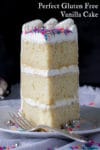
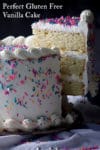
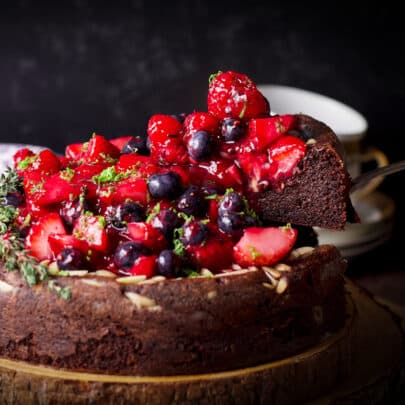
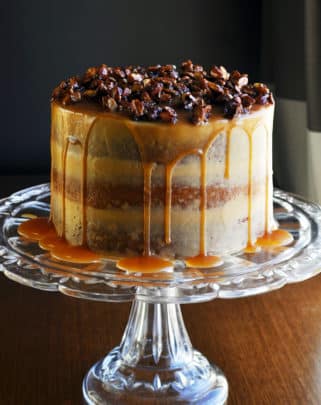
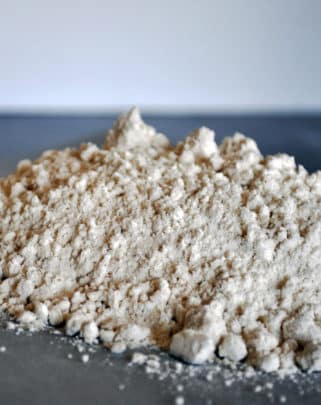
JoAnna says
Can I use regular rice flour instead of brown? I am assuming the Asian rice flour I have is super fine as it looks just like confectioner sugar.
Rebecca Blackwell says
It sounds like the rice flour you have will be fine JoAnna. The important thing is that the flour is very, very finely ground. If yours is the consistency of powdered sugar, I think it will work well. Please let me know if you have any other questions! And I'd love to hear what you think of this cake after you make it! xo
Robin Visser says
This is by far the best GF cake I’ve ever had. My daughter has Celiac's Disease and really misses home baked birthday cakes. Last year her best friend said this cake tasted better than the full gluten ones. That is high praise indeed.
Rebecca Blackwell says
This comment just made my day Robin!!! Thank you so much for taking the time to let me know that you and your family like this recipe! I truly appreciate it! xo
Sarah says
Could coconut milk and coconut milk powder be used in place of the buttermilk and powdered milk?
Rebecca Blackwell says
Hi Sarah! Yes! I don't see any reason why both of those substitutions wouldn't work well. Please let me know if you have any other questions! And, I'd love to hear how this cake comes out for you! xo
Karine Cassidy-Robar says
Hi! This cake looks amazing, and I am wondering if you have tried to make it a marble cake? I have a marble gluten free cake to make, so Im wondering if taking 1 cup of prepaired batter and adding 1/ 6 cup cocoa powder and a tbsp of hot coffee would work?
Rebecca Blackwell says
Hi there! I haven't tried to make this into a marble cake, but I think you're on the right track. However, I think you might have greater success with adding some melted chocolate instead of cocoa powder. When I was working out this recipe for a "regular" marble cake, I tested versions that used cocoa powder and melted chocolate and much preferred the flavor and texture of melted chocolate. I imagine the same technique will work for this cake as well. I'd divide the batter in half and stir about 4 ounces melted semi-sweet chocolate into one half of the batter. Spread half the vanilla batter into the pan, dollop the chocolate batter over it, cover with the remaining vanilla batter, then swirl with a knife.
Please let me know if you have any other questions! And, if this works out well for you, would you let me know? I'm sure other readers would appreciate knowing that they could do the same thing. xo
Audrey says
But for sure a great recipe and closed I got on anything on first try. Thank you for sharing it!
Audrey says
So what’s does The consistency and the end with the batter supposed to look like? It looks like play-Doh given I can’t use rice flour at all so I used coconut flour... I not sure about what I can out with but the batter tastes good just not batter looking?! 🙈
Rebecca Blackwell says
Hi Audrey! By now you've most likely baked the cake. How did it bake up? I'm guessing that the thickness of the batter had to do with using coconut flour instead of rice flour, but am curious about how the cake came out?
Audrey says
It tastes really great! But yeah the consistency was heavy more like a cookie 🙈 their is a cake brand I used to buy for my boys birthdays that didn’t use rice with lot same ingredients. This past year they changed the ingredients and add rice. I was so sad... I used some dairy but it was goats milk and lactose free milk. (So I also skipped on powder milk) I did use regular butter. He can’t hardly have any dairy or wheat and cannot have rice at all So their were some differences. This the first time doing a cake from scratch for him and even tho it was to heavy it tasted like cake. It is so hard to find him baked goods or recipe that work.
Rebecca Blackwell says
It's super challenging (in my experience) to get a good consistency in gluten free cakes without using cake flour. If you also can't use powdered milk, that's even more challenging. I feel for you! Even with all of those obstacles, I love that you forged ahead and made him this cake anyway. If I come across any good gluten free flour mixes that don't use rice flour or milk powder, I'll be sure to send them your way!
Keri says
Thank you so much for this recipe! I’m baking cupcakes for a large crowd with a few gluten intolerant guests Saturday & wanted to find gf recipe everyone will love. I’m excited to try your recipe, especially after reading the reviews! I’m wondering how I should bake these as cupcakes? I know the time will be less, but about how much? And should I change the oven temperature? Thanks!
Rebecca Blackwell says
Hi Keri! I'm excited that you're baking this recipe too! Keep the oven temperature the same - 325 degrees, and bake the cupcakes for 20 minutes. Peak at them, and if they look like they might be done, stick a toothpick in the center of one, pull it out, and see if there's any evidence of raw batter. If they're not quite done, let them bake longer, checking them every 5 minutes.
Please let me know if you have any other questions! And, I'd love to know what you think of this recipe after you bake them! xo
Kirk Hutchinson says
Any chance of making this egg free? I have hashimotos along with an egg allergy unfortunately.
Rebecca Blackwell says
Hi Kirk! There are two egg replacement options that I think will work well in this recipe. Keep in mind that I haven't tried either in this specific recipe, but have had success with both substitutions in other similar recipes:
1. Carbonated water: 1/4 cup carbonated water = 1 large egg
2. Water, oil and baking powder: 2 tablespoons water + 2 teaspoons baking powder + 1 teaspoon vegetable oil = 1 large egg
Both substitutions work surprising well in cakes and muffins and I think would work well in this recipe too. If you try it, would you let me know how the cake came out for you?
Abigail Goldenberg says
Hi just wondering your measurements for a 6 inch cake?
Rebecca Blackwell says
Hi there! If you cut the recipe in half, you should have enough batter for a 6-inch two layer cake. If you're wanting a 6-inch three layer cake, I would suggest making a full batch and then using the leftover batter to make a few cupcakes. The cupcakes will freeze well for up to 3 months. I usually wrap them individually so I can just pull one or two from the freezer at a time. It's kind of nice to have them on hand. I hope that helps! But, please let me know if you have any other questions! And, I'd love to hear what you think of this cake after you make it! xo
Heather says
Good morning, I stumbled across this recipe in my search for a gluten free cake. While I was enjoying your website, I saw your recipe for a champagne cake. I was wondering if it’s possible to adapt the gluten free vanilla cake into a champagne cake? Would it just be a matter of changing out 1/2 of the buttermilk for champagne? Any help would be greatly appreciated. Thank you so much for taking time to answer my questions, I can’t wait to try this cake!
Rebecca Blackwell says
Hi Heather! Great question! I think you could swap out the buttermilk for champagne without it causing any problems with the cake's structure. However, the buttermilk does add tenderness and flavor to the cake that I'm concerned about loosing. Here's what I would do instead: Bake the gluten free cake as directed. Then, pour 1 cup champagne into a small sauce pan and bring to a boil. Simmer until the champagne is reduced to 1/3 cup. Then brush the tops of the cooled cake layers with the champagne reduction. That should impart a nice champagne flavor to the cake. You can also make a Champagne Buttercream to give the cake even more champagne flavor. Please let me know if you have any more questions! And, if you try this, I'd love to know how it works out for you! xo
Ashly says
Could I make this dairy free?
Rebecca Blackwell says
Hi Ashly! Dairy free baking can be tricky, but I think you could try this: Substitute any unsweetened, unflavored non-dairy milk for the buttermilk adding 1 tablespoon of lemon juice for a total measure of 1 cup. Use 1 1/2 cups of shortening and omit the butter. Omit the milk powder and increase the potato starch and tapioca flour by two tablespoons each. I think that will work. If you try it, will you let me know how it goes? xo
stefanie says
this looks GORGEOUS! do you think it would work well enough to sub either granulated coconut sugar or liquid honey or maple syrup? we don't do white sugar but i'm dying to try this one!
Rebecca Blackwell says
Hi Stefanie! I think substituting granulated coconut sugar will work great! Don't use a liquid sugar, because it will mess up the balance of liquid in the cake. But, granulated coconut sugar should work fine. Please let me know if you have any other questions! And, I'd love to hear what you think of this cake after you make it! xo
Amanda Cantrell says
Turned out perfectly! My guests could not believe it was home made, let alone gluten free! I used an American buttercream frosting with your pastry cream recipe for filling the layers. This will be my go-to cake forever, thank you Rebecca!
Rebecca Blackwell says
I am SO happy to hear this Amanda! Thank you so much for taking the time to let me know. Since the cake cake out well for you, my guess is that you achieved enough "smoothness" when whisking the buttermilk and rice flour. The most important thing with cake batter is to get the ingredients well combined and evenly distributed. Usually, if the batter looks smooth, that's a good indication that it's been mixed well enough. With cake batter using regular wheat flour, you have to be careful to not overwork the batter (because it activates the gluten and creates a tough texture). With gluten free cakes, you don't really have to worry about that. So, just mix until the ingredients look well incorporated, and if you're unsure, mix a bit longer without worry. Please let me know if you ever have any other questions! Thank you again for leaving a comment for me! xo
Amanda says
Thank you for your answer! I used cultured,whole fat buttermilk, is that right? I was also wondering if you have a gluten free chocolate cake recipe floating around or if this recipe could adapted?
Rebecca Blackwell says
Yes! Cultured whole fat buttermilk is correct. I haven't worked out a good chocolate gluten free cake yet... Adding a bit of cocoa powder to this recipe might work. I'd start with adding 1/3 cup and then bumping up the sugar by a tablespoon or two. I'll try that soon and let you know how it works out. If you try it first, please let me know how it worked out for you! xo
Amanda Cantrell says
This is in the oven right now, and I have a question about the very first step: what do you mean by smooth? When I whisked the full fat buttermilk and super fine brown rice flour together it resulted in a dough like consistency. When I added all together at the end the batter came out as I expected (and tasted delicious!) But that really threw me. I sifted and re-measured with the exact same results. Am I doing something wrong?
Rebecca Blackwell says
Hi Amanda! By now your cake must be out of the oven... how did it come out?
Amanda says
Not sure yet! Layers are in the freezer until my twin girls 3rd birthday sunday. They baked up nice and even and felt sturdy. Making your pastry cream now! Would still like to know how to tackle that first step of the recipe with the rice flour and buttermilk. There are several celiacs in the family and I would like to make this again!
Joy says
Hi, out of curiosity, have you ever done recipes by weights, or do you typically get consistent results with volume measurements? (I have an amazing ability to mess up recipes, and weight measurements have reduced my problems somewhat, ha!)
Rebecca Blackwell says
Hi Joy! Measuring by weight is more accurate, it's true. However, after baking for 25 years using volume measurements, I rarely have an issue. Having said that, I do plan on updating the recipes published here to include both weight and volume measurements for recipes, just to give people the option. xo
Jonathan Linn says
Hi. Could i substitute white rice flour instead of brown rice flour? I'm looking for a cake recipe where the cake is more white than yellow. Thanks for your help
Rebecca Blackwell says
Hi Jonathan! Great question. I think substituting one for the other should be fine. Brown rice flour has a tad more protein than white rice flour, but I don't think it's enough of a difference to matter. My hesitation only comes from the fact that I haven't baked this cake with white rice flour. But, I think it will be fine. What's more important is trying to find "superfine" ground rice flour. The cake will still bake up well if the rice flour isn't superfine, but it will have a slightly gritty texture. The superfine rice flour ensures that the texture is extremely tender and not gritty at all. Please let me know if you have any more questions! And, I'd love to know what you think of this recipe after you bake it! xo
Pat says
Can one add simple syrup to this cake or even a rum sauce? if making for a wedding cake, can it be refrigerated to set the frosting without the cake drying out? And, how many days will this cake last?
Rebecca Blackwell says
Hi Pat! Yes - you could brush the cake layers with simple syrup if you like. Rum sauce would be even more delicious. Even though it's gluten free, the cake's texture is just like any other cake and can hold up to any kind of frosting, filling, or sauce. If the cake is frosted, I think you could get away with refrigerating it for up to 3 days with no issues. However, since it's for a wedding cake, I'd suggest being a bit more cautious and refrigerating it for no more than 48 hours. You can freeze the layers, wrapped individually, unfrosted, for up to 3 months.
Please let me know if you have any other questions! And, I'd love to know what you think of this recipe after you make it. xo